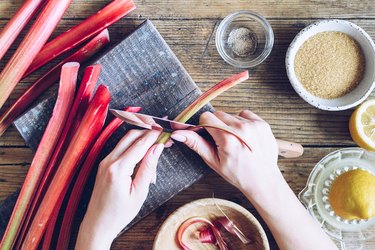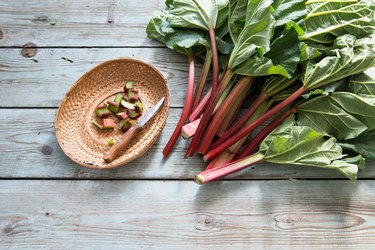
Burdock and rhubarb have funny-sounding names and they've both been used in Chinese medicine for centuries. Burdock is sometimes called "wild rhubarb" but the similarities pretty much end there.
Here's what you need to know about the differences between rhubarb and burdock, and whether both are edible.
Video of the Day
Video of the Day
What Is Rhubarb?

Rhubarb is found in three varieties: red, green or speckled, per the University of Wisconsin-Madison. The colors refer to the fibrous edible stalk of the plant.
The rhubarb plant is large and typically requires 3 feet of garden space, per the Ohio State University Extension. The smooth stalks can reach a length of 2 to 4 feet and a width of 2 inches. Cross-sections of the rhubarb stalk are solid. Rhubarb leaves are large, smooth, dark green when mature and have curled edges.
Rhubarb is grown in cool weather, but it's also a common and easy-to-grow plant for the home gardener.
What Is Burdock?

Burdock is easily confused for rhubarb due to its appearance and its misleading common name, "wild rhubarb," per the Ohio State University. Burdock is a prolific weed throughout the U.S., so it is not surprising when it shows up in home gardens.
To identify burdock, look for mature leaves that are less curly than rhubarb. The undersides of burdock leaves are wooly or hairy, unlike rhubarb.
Another easy way to identify burdock is to cut away a cross-section of its stem. Burdock has a hollow stem, whereas rhubarb stems are solid. When left to mature, burdock can reach 5 feet tall and make purple thistle-like flowers surrounded by rigid hooked bristles. These bristled burs are known for sticking to clothes, sheep's wool and dog fur.
Usage
You can only eat the stem of the rhubarb plant (either raw or cooked). The leaves are poisonous, according to the USDA SNAP-Ed Connection. When eaten raw, the rhubarb stalk is generally sour and fibrous. Cooked rhubarb adds a tangy, fresh flavor to pies, tarts, sauces and fruit spreads.
You can eat burdock raw or cooked, according to the Utah State University Extension. Most parts of the plant, including the roots, the leaves and the stems, are edible. Burdock is sometimes listed as an ingredient in health supplements and folk remedies.
Toxicity
Only the stalks of rhubarb are edible, as the leaves contain a toxic amount of oxalic acid, which can cause cramps, nausea and (at worst) death, per the University of Wisconsin-Madison. Do not eat rhubarb stalks that have been hit by hard frost, as severe cold can cause oxalic acid to develop in the stalks, per the Ohio State University Extension.
Burdock root is edible. According to the Ohio State University Extension, common burdock has potential diuretic effects. The burs can also cause skin irritation when they become hooked on the skin.
Burdock vs. Rhubarb Nutrition Facts
Per 4 oz. | Burdock | Rhubarb |
|---|---|---|
Calories | 82 | 24 |
Total fat | 0.2 g | 0.2 g |
Total carbs | 19.7 g | 5.1 g |
Sugar | 3.3 g | 1.2 g |
Fiber | 3.7 g | 2 g |
Protein | 1.7 g | 1 g |
Potassium | 7% Daily Value (DV) | 7% DV |
Vitamin K | 2% DV | 28% DV |
Although neither burdock nor rhubarb is especially high in vitamins and minerals, they're both rich in antioxidants.
According to September 2012 research in the International Journal of Food Science and Technology, some varieties of rhubarb even have more of a specific class of antioxidants — called phenolics — than kale.
In addition to acting as powerful anti-inflammatories, phenolic compounds are linked to helping fight infections, lower rates of degenerative diseases, alleviating allergies and supporting the immune system, per an October 2014 report in the International Journal of Chemical Engineering and Applications.
Potential Benefits
Another similarity between burdock and rhubarb is that they're both used in some cultures' herbal medicine practices. Although their specific uses are different, they're still both popular choices for various conditions.
Rhubarb
A December 2017 report in Chinese Medicine calls rhubarb one of the most common and important herbs in Chinese medicine. More research needs to be done to confirm any potential benefits of rhubarb. That said, the report notes that rhubarb is linked to:
- Regulating digestive health
- Protecting your kidneys
- Supporting heart health
- Protecting your brain
- Lower levels of inflammation
- Fighting off pathogens, like bacteria and viruses, that can cause infections
Burdock
There's not a lot of current research on the health effects of burdock, but, according to an older October 2011 report in Inflammopharmacology, the root part of the plant is associated with:
- Detoxifying the blood
- Improving blood circulation
- Improving skin quality/texture
- Reducing the severity of skin diseases, like eczema
The same report notes that burdock also has anti-inflammatory properties, similar to rhubarb. But more research needs to be done in order to confirm both plants' benefits.